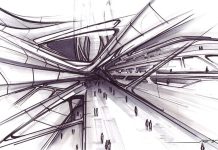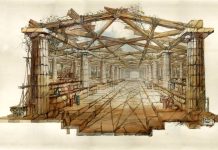On the larger side of the trapezoid, along the axis of movement and symmetry of the square, the main dominant building of the ensemble is located, the sides of the square are decorated less ceremoniously. And they are buildings whose facades are almost always decorated with a long metric row of columns, pilasters, galleries without any accent in length, the sides make up an average angle of 5°-7° with the axis of the square.
It is known that such squares give the viewer the impression of greater freedom and spatial, and the main building is given significance and expressiveness. The reasons for such an impact can be identified by analyzing one of the trapezoidal squares (Greece, Asia Minor, III century BC).
The square has an elongated shape of an irregular trapezoid. On the opposite side of the square from the entrance there is a small antique temple. The sides of the square are built up with buildings facing the square with galleries (baths on the left, two-tiered public galleries on the right). When building the square, the nature of the relief, steeply descending to the city, is taken into account. This explains that the right side of the square is built up with a two-story gallery twice as high as the building of the opposite side of the square. Due to the different building heights of the sides of the square, the left side of the building was rotated from the axis of the square by an angle 2 times greater than the right, i.e. by 6° versus 3°. Thus, the strengthening of the prospective reduction due to a greater turn of the left side corrected to some extent the different height of the building. The perspective vanishing point for the left side of the square is twice as far from the main point of view as the right one, whereas with parallel construction there would have to be a common vanishing point. It is interesting to note another such moment. The two-tiered galleries are higher in absolute size than the temple.
In order to visually, in the future, reduce their height at the end of the square, where they can easily be compared with the height of the temple, the galleries are continued somewhat further than the main facade. Due to the perspective reduction, the galleries visually seem at least equal to the height of the temple.
The deviation of the sides from the parallel position to the axis of the square creates a certain perspective effect, which, as it were, increases the length of the square, which makes the main building perceived more significant and expressive. This impression is also caused by the fact that the viewer, when perceiving, is characterized by a quick and subconscious comparison in perspective of the height of closely spaced columns with remote ones located at the end of the square, next to the main building. The trapezoidal shape enhances the impression of the length of the side building, while visually compressing the trapezoidal base. However, at a low level of the viewer’s horizon, the base of the square is viewed from a strong angle and therefore does not affect the perspective effect created by the deviation of the lateral development from the axis of the square.
In other trapezoidal squares, a similar scheme of compositional construction of the ensemble is applied. Let’s consider some features of using this technique.
Trapezoidal square in front of the Cathedral of St. St. Peter’s in Rome rises towards the cathedral. Along with the base of the square, the side galleries rise, treated with pilasters and completed with an entablature. Trapezoidal in terms of the area gives greater perspective to the sides, as a result of which the increase of the entablature towards the main facade of the cathedral is not perceived in the future and becomes invisible.
The Capitol Square in Rome, thanks to its trapezoidal shape, creates the same promising effect. Here is an interesting technique applied to the stairs leading to the square. The staircase also has a trapezoidal shape with an extension in the direction of movement. However, this achieves the opposite effect. A staircase that is long in length is perceived to be shorter, since we consider an inclined trapezoidal base, the perspective of which decreases.


















